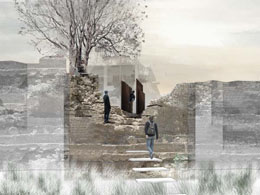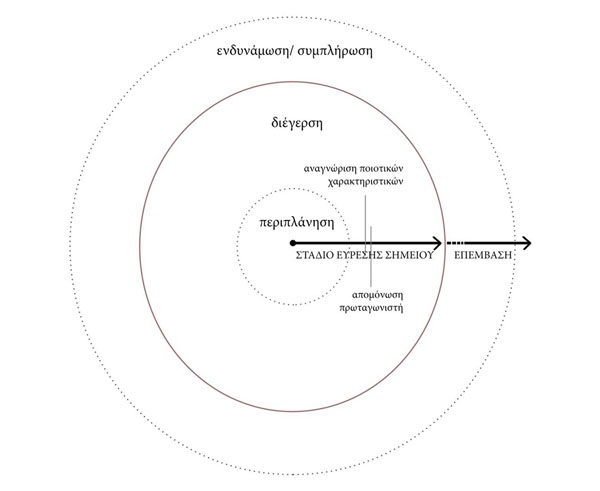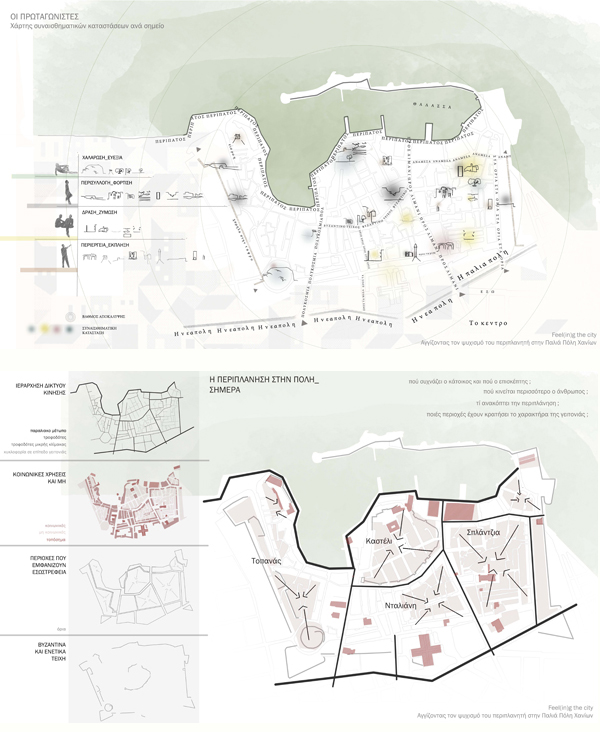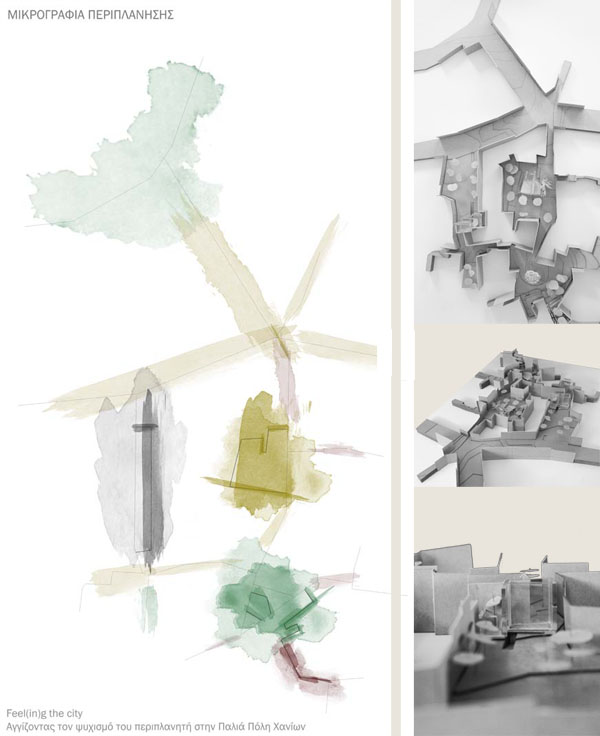STUDENTS PROJECTS
PROJECTS2013

01 February, 2015
Feel(in)g the city
Reaching the wanderer's disposition into the Old Town of Chania.
Students: Kolokythakou Theodora-Danai, Ragkavani Eleni, Stayrakaki Marilena
Supervisor: Ouggrinis Konstantinos-Alketas
Consultant: Tzompanakis Alexios
Technical University of Crete
Date: 14th of July 2014
The scope of this thesis is the arousal of people's emotions through their experience in the surrounding urban scenery. This urban scenery does exist; it is being reinforced and enriched with a meaningful content capable to influence someone's disposition, participation and needs.
After looking for those notions which connect people, the city and their movement in it, we clarified the notion "wanderer", while exploring congnate notions such as: stroller, excursionist, flaneur, to wander, wandering. Through this research we decided to define the notion "wanderer" as someone walking without a cause; someone without a determined course or someone who diverted from it. The wanderer observes the urban scenery, thoroughly or not. Sometimes, he/she remains distant, while others he/she participates in what happens around. His/her movement is influenced by the city's characteristics, such as the architecture, the history, the decoration, the scenery, the light, the sounds, the climate, people, the textures etc. Additionally, the wanderer's phychology, such as the desires, the disposition, the feelings and the needs, are crucial.
The "wandering" takes place in the Old Town of Chania; a -space and time- palimpsest which is "extrovert" - as far as the social and commercial places of strolling and leisure time are concerned - and at the same time, "introvert" - as for the hidden neighborhoods into the complex, medieval structure. This "introversion" points out the" unseen dynamics" of the Old Town of Chania; the trigger of the wandering in it.
Eventually, what we do is dredging the Old Town's "unseen dynamics" up , by forming spotted spatial "episodes" (i.e. interventions), so as to arouse the wanderer's emotions.

We walked through quiet and isolated areas, "extrovert" plateaus, "dramatic" paths of antithesis, historical and monumental places and quiet neighborhoods, meeting and interacting with amicable local residents.
What plays a significant role in the design process is the "protagonist" of each spot; that very element that prevails in the area i.e. an arch, a tree etc.
All the same time, a factual analysis of the Old Town of Chania aims at collecting data referred to people's mobility in the city, the neighborhoods, the contemporary wandering etc.

We noticed that, in spite of the unique atmosphere of every spatial "spot", some characteristics are also revealed elsewhere. Summarizing these characteristics, we formed four emotional states for the wanderer to surrender to and experience. Additionally, we used a variety of different design tools, materialities and textures for each emotional state.
Spots characterized by extroversion and sociability tend to make people - wanderers, residents etc - gather together at first and then participate in the facts and interact with each other. This state is called "action and interaction". The design tools are mostly horizontal surfaces of action, engravings on the floor, seats designed to promote interaction between people. The materials used are user-friendly, such as wood, fabric and sand.
Spots characterized by the presence of monumental scale buildings and historicity belong to the "contemplation and emotional strain" state. The design tools are vertical surfaces, frames, "lone" seats, transitions in height which are meant to give specific visual information to the wanderer. The materials used are hard, steely, reflective or not, such as corten steel, concrete, mirrors.
Spots characterized by naturalism, simplicity and quiet belong to the "relaxation and wellness" state. The design tools are mostly seats which favor comfortable posture of the body, plants which provide shade, frames towards the landscape. The materials used are wood, soil, fabric and water which are user-friendly and flexible materials.
Finally, spots characterized by transitions, alternations and obscurity belong to the "curiosity and surprise" state. The design tools vary; they are steep stairs, high walls obstructing the view, panels alternating light and shadow, suspended pathways. The materials used are not strictly defined. We use uncoated concrete, corten steel - perforated or solid, wire rope.

We decided to render the designed spots in plans or in sketches. Every spot holds its unique identity comprised of the spot's picture, the protagonist, the existent plan, the design tools, the intensity of the state, the textures, the materials - existent or new - the location and the name of the spot.
Additionally, it is of great importance the way of approaching each spot from the most public places of the city, as well as the possibility - if it is easy or not- each spot to be revealed by the wanderer. A designed spot could be easy to reach or totally hidden in the city's network. In some cases, we seek to locate spatial "hints", perceivable or not by the wanderer. Whether the wanderer perceives the "hints" or not, depends on them.
The designed spots have been described and portrayed for each neighborhood, according to their distance from each other. We decided to design thoroughly four spots - one of each emotional state - so as to point out the different ways we handled each state. These spots are in close proximity with each other. In this way, there is a sequence in the wanderer's motion, since when leaving from a spot, he/she may finds a visual or acoustic stimulus, so as to continue to the next spot. Ηis/her course in the city depends on his/her percipience every single moment, thus providing him/her with the potential of "interpreting" the city itself, in a different and experiential manner every time.


Νταλιάνη
Καστέλλι
Τοπανάς












